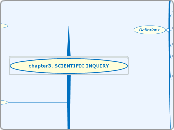chapter3. SCIENTIFIC INQUIRY
State of the art in business research
Levels of scientific endeavor
control exists when the researcher is able to manipulate on or more variable in problem situation so as the effect the desired change in one or more variables associated with the situation
explanation is achieved when the research can answer why a certain phenomenon or relationship exists in reality
prediction is achieved when the researcher can identify a variable or set of variables that is associated with the presences of some other variable
description is the simple identification of the major variables and their relationships in a problem situation
the changes in the business research industry
Shared information and technology will lead to better theoretical networks
New research techniques promise to make research settings more realistic and ultimately improve the quality of the research
the field will function more and more in real time
the research function will become increasingly woven into the fabric of the organization
compared to the natural sciences
such as physics and chemistry
categorized as applied social science research in most classificatory schemes
Relevance of science in business research
scientific method
systematic
empirical
conceptual and theoretical in nature
objective
logical
critical and analytical in nature
Science versus nonscience
to outline the basic terminology in the field of science
to build the case for the need for research in the decisionmaking process
Methods of theory construction
Deductive Theory
deductive theories are developed largely through the process of deduction
one whose emphiasis is distinctly on the conceptual structure and its substantive validity
a widely used form of inferential logic
form of inferece that derives its conclusions by reasoning through premises which serve as its proof
Funtional theory
difference between deductive and functional theeories
is the degree to which conceptualization takes place ini the early stages of the theory's development.
functional theories are those whose developemtn is characterized by a continual interaction of conceptualizing and subsequent empirical testing
inductive theory
Definition
inductive theory building is characterized by a strictly empirical approach to finding generalizations
Model-based Theory
emphasis up front is on defining a conceptual network
use of symbols or other such physical analogs
any highly formalized representation of a theoretical network
Defintions
Theories
can be defined as interrelated set of statements of relationship whose purpose is to explain and predict
the establishment of theories is a primary goal of science because they are the means by which we explain and predict phenomena of interest
Expectancy theory
a good example in use
expectancy
working
harder --------------->increase productivity
instrumentality valence
---------------->incentive bonus------------------>
desirability of incentive bonus
Effort
the amount of work expended to achieve a specific task
Valence
the value that a person places on the outcome
instrumentality
the perceived likelihood that a successful performance will lead to desired outcomes
expectancy
the perceived likelihood that an action will lead to successful performance
guiding the enterprise of discovering new and more powerful generalizations
modify them to fit data unanticipated in their formulation
the device for interpreting, criticizing and unifying established law
more effectively bring to bear our repertoire of habits
Models
General model
effort=expectancy* instrumentality*Valence
simplified versions of phenomena that are of interest to the scientist.
used as representations of theoretical systems so that they can be tested, examined, and generally analyzed by those who create them
as any highly formailzed representation of a theoretical network, usually designed through the use of symbols or other such physical analogs
Laws
a law can be defined as a well-verified statment of relationship about an invaribale association amonyg variables
Hypotheses
tentative statements
are considered to be plausibele given the available information
conjectural statements
conjectural statments of the the relationship between two or more varibales that carry clear implications for testing the stated relation
Problem
infinite
questions raised that are in need of a solution in a business setting
Variables
assume any one of a set of values
simply a symbol
Definitions
Operational
Constitutive
constructs
not directly tied to observation
invvented for some speical theoretical purpose
High levels of abstraction
Concepts
abstract ideas generalized from particular facts
the basic building blocks of scientific investigation
facts
those thngins or phenomena that we believe are tru. facts are generally consensual in nature, in that others who have observed the same phenomena agree to their existence
questioning of inidividuals
reports and publications of fact-gathering agencies and researchers
original documents
Direct infereence from other data that are directly oberved
Direct observation or sensing of natural phenomena or of experienmetal result
observations
ttthey are our perceptions of reality. they are experiential in nature.
by note facts
by which we recognize

